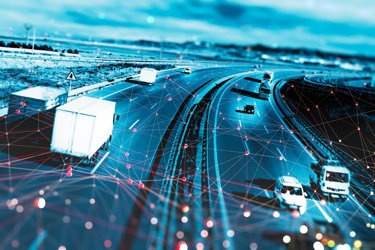AVs, CVs Relying More On Radar Technology, Rigorous Testing Needed

By John Oncea, Editor

Advanced radar technologies are revolutionizing autonomous vehicle development, enabling safer and more reliable sensor systems that can detect objects and navigate complex environments under diverse conditions.
CES 2025 is an event where brands get business done and meet new partners. It’s also where the industry’s sharpest minds take the stage to unveil their latest releases and boldest breakthroughs.
This includes one of our partners, Rhode & Schwarz, which used CES 2025 to unveil R&S RadEsT, its latest automotive radar testing innovation. R&S RadEsT is a radar target simulator that meets the full range of testing needs – from lab-based functional testing to vehicle-level production checks and beyond.
Rhode & Schwarz was not alone in showcasing radar test solutions:
- NOVELIC presented its suite of millimeter-wave (mmWave) radar sensor solutions
- Texas Instruments unveiled new automotive SoCs, including a radar sensor designed to enhance passenger safety
- Ansys demonstrated its simulation solutions that assist automotive suppliers in accelerating the design and integration of radar technologies
- Arbe showcased its advanced radar technology, offering a “Grand Unified Perception Model” that integrates radar data into OEM perception systems for autonomous driving
The investment in and release of these technologies demonstrates the importance of enhancing radar testing and integration to support the development of autonomous and connected vehicles. Let’s dig deeper into that.
ACVs, Radar, And The Future Of Transportation
The rapid evolution of autonomous and connected vehicles (ACVs) is reshaping the future of transportation, promising enhanced safety, efficiency, and convenience. Central to realizing this potential is the integration of advanced sensor technologies, with radar systems playing a pivotal role. Enhancing radar testing and integration is crucial to support the development of ACVs, ensuring they can navigate complex environments reliably and safely.
Radar sensors are indispensable in ACVs due to their ability to detect objects, measure distances, and assess velocities under various environmental conditions, including adverse weather and low visibility. Unlike cameras and LiDAR, radar’s robustness to environmental factors makes it a reliable source of information for vehicle perception systems.
In advanced driver assistance systems (ADAS) and autonomous driving, radar sensors act as the vehicle’s eyes and ears, working alongside cameras, LiDAR, and ultrasonic sensors to create a comprehensive understanding of the vehicle’s surroundings, notes Keysight Technologies. The vehicle’s electronic control unit (ECU) uses sensor fusion to combine data from all sensors, forming a coherent, real-time 3D picture that enables decision-making related to driving assistance and autonomous functions.
Advancements In Radar Technology The Importance Of Rigorous Testing
Recent collaborations between industry leaders have propelled radar technology to new heights. For instance, Analog Devices, Inc. and Astyx have partnered to develop high-performance radar systems tailored for autonomous vehicles. This collaboration focuses on creating radar systems capable of detecting, discerning, and understanding the entire environment around the automobile, which is essential for achieving fully autonomous driving.
As radar technology becomes more sophisticated, rigorous testing is imperative to ensure its reliability and effectiveness in real-world scenarios. Advanced radar test systems, such as those developed by Dspace, play a crucial role in this process. These systems simulate complex driving scenarios to rigorously test radar-based perception systems, ensuring they perform accurately under diverse conditions.
Moreover, writes Electronics For You, next-generation radar testing systems are being developed to simulate comprehensive driving scenarios, allowing for the evaluation of radar performance in a controlled environment. These systems enable the testing of radar sensors’ ability to detect and respond to various objects and situations, which is critical for the safe deployment of autonomous vehicles.
Integration Challenges And Solutions
Integrating radar technology into ACVs presents several challenges, including interference management, sensor fusion complexities, and ensuring compatibility with other vehicle systems. Research efforts are underway to address these challenges.
For example, according to ArXiv a study on space-time adaptive processing for radars in connected and automated vehicular platoons explores methods to enhance target detection performance while minimizing interference.
Additionally, intelligent real-time dual-functional radar-communication systems are being developed to enable vehicles to perform both radar sensing and data communication functions. ArXiv notes this dual functionality maximizes bandwidth utilization and enhances safety by allowing vehicles to transmit data and detect objects simultaneously.
The Role Of Testing Facilities And Regulators
Testing facilities like Mcity, a 32-acre mock city and proving ground at the University of Michigan, provide controlled environments specifically designed to test connected and automated vehicle technologies. These facilities enable researchers and industry professionals to evaluate radar systems' performance in simulated urban environments, facilitating the development and integration of reliable radar technologies in ACVs.
The integration of radar technology in ACVs also involves navigating regulatory landscapes. Reuters reports the U.S. Commerce Department has proposed rules to address national security risks associated with software in autonomous and connected vehicles, emphasizing the importance of secure and reliable sensor integration.
Enhancing radar testing and integration is vital for the advancement of autonomous and connected vehicles. Through collaborative development, rigorous testing, and innovative integration strategies, radar technology can meet the high demands of ACVs, ensuring they operate safely and effectively in complex real-world environments. As research and development continue, and with the support of dedicated testing facilities and thoughtful regulatory frameworks, radar systems will remain at the forefront of autonomous vehicle technology, driving the future of transportation forward.
